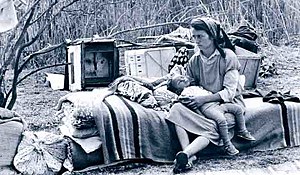Refugees in Azerbaijan
Azerbaijan has a large number of
Refugees from Armenia

According to the 1979 census, Azeris numbered 160,841 and constituted 5.3% of Armenia's population.
Thus, in 1988–91 the remaining Azeris were forced to flee primarily to Azerbaijan.[5][10][11] It is impossible to determine the exact population numbers for Azeris in Armenia at the time of the conflict's escalation since the 1989 census forced Azeri migration from Armenia was already in progress. UNHCR's estimate is 200,000 persons.[6]
According to the Azerbaijani government at the time of the ceasefire in 1994 there were about 250,000 Azeri refugees from Armenia.[12] According to the 1998 Citizenship Law they are all eligible for citizenship. By the end of 2001, UNHCR estimated that most of them were believed to have naturalized or be in the process of doing so.[13]
Internally displaced persons from Nagorno-Karabakh and the adjacent territories
This section needs to be updated. (October 2023) |

During the
The Government of Azerbaijan with the help of the international community has started drafting a Framework Plan for the Return of IDPs to the occupied regions after the settlement of the Nagorno-Karabakh Conflict (The Great Return Programme).[12]
Meskhetian Turks
In 1944,
Statistics

According to State Committee of Azerbaijan for Refugees and Internally Displaced Persons, there were 603,251 IDPs in Azerbaijan in March 2009. The majority live in and around Baku, as well as in Sumgayit. Significant numbers of IDPs also live along the central-southern route of
Problems
Although relations between IDPs and the local population are generally amicable and there is a high level of tolerance among the local population, there are instances of conflicts arising due to the special status of IDPs (such as privileged access to employment, government financial assistance, free health services and property ownership privileges).[12]
Gallery
References
- ^ "Адекватному пониманию армяно-азербайджанского конфликта мешает распространение и повторение ложной статистики". BBC. 15 July 2005. Archived from the original on 13 April 2014.
Общее число перемещенных лиц среди азербайджанского населения составляет около 750 тыс. чел., что существенно меньше "одного миллиона", которым регулярно оперировал президент Алиев. Однако все равно это весьма внушительная цифра. Сюда входят 186 тыс. азербайджанцев, 18 тыс. курдов-мусульман и 3,5 тыс. русских, которые в 1988-1989 годах переехали из Армении в Азербайджан
- ^ "All-Soviet Population Census of 1979 - Ethnic Composition in the Republics of the USSR: Armenian SSR". Demoscope.ru (in Russian).Archived 27 September 2007 at the Wayback Machine
- ^ a b Svante Cornell. "The Nagorno-Karabakh Conflict". Sakharov-Center.ru (in Russian).Archived 6 June 2011 at the Wayback Machine
- ^ a b "Karabakh: Timeline of the Conflict". BBC Russian (in Russian).Archived 11 July 2012 at archive.today
- ^
- ^ a b "International Protection Considerations Regarding Armenian Asylum-Seekers and Refugees" (PDF). United Nations High Commissioner for Refugees. Geneva. September 2003. Archived (PDF) from the original on 3 November 2008. Retrieved 8 October 2010.
- ^ Yazep Abzavaty (15 January 2007). "The Unrecognized IV. The Bitter Fruit of the 'Black Garden'". Nashe Mnenie. Retrieved 1 August 2008.Archived 20 November 2008 at the Wayback Machine
- ^ "Pogroms in Armenia: Opinions, Conjecture and Facts- Interview with Head of the Armenian Committee for National Security Usik Harutyunyan". Ekspress-Khronika #16 (in Russian). 16 April 1991. Retrieved 1 August 2008.Archived 21 July 2011 at the Wayback Machine
- ^ "Əsir və itkin düşmüş, girov götürülmüş vətəndaşlarla əlaqədar Dövlət Komissiyası". www.human.gov.az. Archived from the original on 30 September 2011. Retrieved 7 October 2010.
- ^ "UNHCR U.S. Department of Homeland Security, Citizenship and Immigration Services Country Reports Azerbaijan. The Status of Armenians, Russians, Jews and Other Minorities". www.unhcr.org. Archived from the original on 19 October 2012. Retrieved 7 October 2010.
- ^ "Country Reports on Human Rights Practices - 2004: Armenia". U.S. Department of State.Archived 28 February 2020 at the Wayback Machine
- ^ a b c d e "Azerbaijan: Analysis of Gaps in the Protection of Internally Displaced Persons (IDPs) United Nations High Commissioner for Refugees". United Nations High Commissioner for Refugees (UNHCR). Archived from the original on 28 June 2017. Retrieved 3 January 2021.
- ^ Refugees, United Nations High Commissioner for. "Refworld | International Protection Considerations Regarding Azerbaijani Asylum-Seekers and Refugees". Refworld. Archived from the original on 11 August 2013. Retrieved 3 January 2021.
- ^ "Global Report on Internal Displacement". Internal Displacement Monitoring Centre. Archived from the original on 1 September 2018. Retrieved 5 September 2018.
External links
- The impact of the global food crisis on Azerbaijan - in pictures
- State Committee of the Republic of Azerbaijan on Deals of Refugees and Internally Displaced Persons Archived 2 November 2011 at the Wayback Machine
- The United Nations High Commissioner for Refugees
- The U.S. Committee for Refugees and Immigrants
- The Internal Displacement Monitoring Centre (IDMC)
- Danish Refugee Council


























